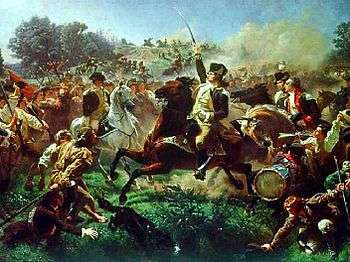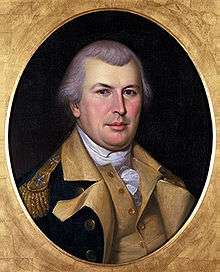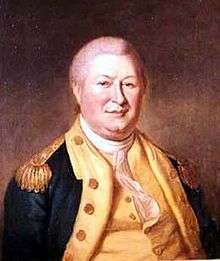Monmouth order of battle

The Battle of Monmouth on June 28, 1778 saw a colonial American army under Major General George Washington fight a British army led by Lieutenant General Henry Clinton. After evacuating Philadelphia, Pennsylvania on June 18, Clinton intended to march his 13,000-man army to New York City. Washington sent 6,400 troops commanded by Major General Charles Lee to attack the British column of march near Monmouth Court House, New Jersey. When Clinton counterattacked, Lee ordered his badly deployed troops to fall back immediately. Washington brought up 7,000 men to support Lee's withdrawing wing and held his ground against repeated British assaults. That evening Clinton retreated from the field and continued his march to Sandy Hook, where the British fleet waited to ferry his army to New York. Both armies' casualties were about even in the last major battle in the northern colonies. Lee was court martialed for his behavior during the battle.[1]
British Army order of battle

Lieutenant General Henry Clinton (12,000-13,000)[2]
Brigadier General Sir William Erskine, 1st Baronet, Quartermaster General
1st Division
Lieutenant General Charles Cornwallis, 1st Marquess Cornwallis[3]
- Artillery: Two 12-pound, 12 6-pound, and two 3-pound guns
- Unbrigaded:
- 16th Light Dragoons
- Queen's Rangers
- 1st Light Infantry Battalion, Lieutenant Colonel Robert Abercromby of Airthrey[4]
- 14 light companies of the line
- Guards Brigade: Brigadier General Edward Mathew[5]
- Elements of 1st Foot Guard, 2nd Foot Guard, and 3rd Foot Guard Regiments
- 1st Battalion[6]
- Grenadier company, Lieutenant Colonel Sir George Osborn, 4th Baronet[7]
- Hyde's company
- Wrottesley's company
- Cox's company
- Garth's company
- 2nd Battalion
- Stephen's company
- Murray's company
- O'Hara's company
- Martin's company
- Light company
- Grenadiers:[8]
- 1st Grenadier Battalion, Lieutenant Colonel William Medows
- 16 grenadier companies of the line
- 2nd Grenadier Battalion, Lieutenant Colonel Henry Monckton †
- 15 grenadier companies of the line
- 1st Grenadier Battalion, Lieutenant Colonel William Medows

- 3rd Brigade: General Charles Grey, 1st Earl Grey
- 4th Brigade: Commander unknown[9]
- 5th Brigade: Brigadier General Alexander Leslie
- Hessian Brigade: Colonel Johann August von Loos[10][11]
- Linsing Grenadier Battalion
- Minningerode Grenadier Battalion
- Lengerke Grenadier Battalion
2nd Division

Lieutenant General Wilhelm von Knyphausen (not engaged)[12]
- Unbrigaded:
- 17th Light Dragoons
- 2nd Light Infantry Battalion, Major John Maitland[13]
- 14 light companies of the line
- Hessian Jäger: Lieutenant Colonel Ludwig von Wurmb
- Foot Jäger company, Captain Johann Ewald[14]
- Foot Jäger company, Captain Carl Wreden
- Mounted Jäger company, Captain Richard Lorey
- Maryland loyalists
- Pennsylvania loyalists
- West Jersey loyalists
- 1st Brigade: Major General James Grant[15]
- 2nd Brigade: Major General Grant
- Hessian Brigade: Major General Johann Daniel Stirn[16][17]
- Erbprinz Infantry Regiment
- Donop Infantry Regiment
- Mirbach Infantry Regiment
American Army order of battle

Major General George Washington (11,000)[18]
- Quartermaster General: Major General Nathanael Greene
- Inspector General: Major General: Friedrich Wilhelm von Steuben
- Senior Artillery Officer: Brigadier General Henry Knox
- Senior Engineer Officer: Brigadier General Louis Lebègue Duportail
- Adjutant General: Colonel Alexander Scammell
- Commissary Generals: Colonels Jeremiah Wadsworth and Clement Biddle
- Judge Advocate General: Colonel John Lawrence
- Military Secretary: Lieutenant Colonel Robert H. Harrison
- Assistant Secretary: James McHenry
- Aide-de-camp: Lieutenant Colonels John Fitzgerald, Alexander Hamilton, John Laurens and Richard Meade
- Volunteer aides-de-camp: Brigadier Generals Joseph Reed and John Cadwalader
Advanced Guard

Major General Charles Lee[19]
- Staff:
- Acting Adjutant General: Lieutenant Colonel John Brooks
- Aide-de-camp: Captains John Francis Mercer and Evan Edwards
- Senior Artillery Officer: Lieutenant Colonel Eleazer Oswald
- Deputy Inspector: Jean Baptiste Ternant
- Advisers: Brigadier General David Forman and Colonel François de Malmedy
- Wayne's Command: Brigadier General Anthony Wayne (est. 1,000)
- Detachment: Colonel Henry Livingston, Jr. (of the 4th New York)
- Detachment: Colonel Walter Stewart (of the 13th Pennsylvania)
- Detachment: Colonel James Wesson (of the 9th Massachusetts)
- Company, 3rd Continental Artillery Regiment: Captain Thomas Seward (2 guns)
- Scott's Command: Brigadier General Charles Scott (est. 1,440)
- Detachment: Colonel Richard Butler (of the 9th Pennsylvania)
- Detachment: Colonel Joseph Cilley (of the 1st New Hampshire)
- Detachment: Colonel Mordecai Gist (of the 3rd Maryland)
- Detachment: Colonel Richard Parker (of the 1st Virginia)
- Company, 3rd Continental Artillery Regiment: (4 guns)
- Varnum's Brigade: Colonel John Durkee (est. 300)
- 1st and 2nd Rhode Island Regiments: Lieutenant Colonel Jeremiah Olney
- 4th and 8th Connecticut Regiments: Colonel John Durkee
- Company, 3rd Continental Artillery Regiment: Captain David Cook (2 guns)
- 4th Virginia (Scott's) Brigade: Colonel William Grayson (est. 600)
- 4th, 8th and 12th Virginia Regiments: Colonel James Wood
- Grayson's Additional Continental Regiment: Colonel William Grayson
- Patton's Additional Continental Regiment: Colonel John Patton
- Company, 3rd Continental Artillery Regiment: Captain Thomas Wells (2 guns)
- New Jersey Brigade: Brigadier General William Maxwell (est. 1,000)
- 1st New Jersey Regiment: Colonel Matthias Ogden
- 2nd New Jersey Regiment: Colonel Israel Shreve
- 3rd New Jersey Regiment: Colonel Elias Dayton
- 4th New Jersey Regiment: Colonel Ephraim Martin
- Militia Light Horse: Lieutenant Colonel Anthony Walton White (40–50 horsemen)
- Company, 2nd Continental Artillery Regiment: Captain Thomas Randall (2 guns)
- Jackson's Detachment: Colonel Henry Jackson (est. 200–300)
- Henley's Additional Continental Regiment: Major John Tyler
- Jackson's Additional Continental Regiment: Colonel Henry Jackson
- Lee's Additional Continental Regiment: Lieutenant Colonel William Smith
- New Jersey Militia Brigade: Brigadier General Philemon Dickinson (est. 800)[18]
- 1st, 2nd, 3rd and 4th Hunterdon Militia: Colonels Philips, Beavers, Chambers and J. Taylor
- 1st, 1st, 2nd and 3rd Middlesex Militia: Colonels H. Van Dyke, J. Webster, Neilson and J. Hyer
- 1st and 2nd Somerset Militia: Colonels F. Frelinghuysen and Van Dyke
- 1st Burlington Militia: Colonel W. Shreve
- 3rd Monmouth Militia: Colonel D. Hendrickson
Right Wing
On command officers led detachments in the Advance Guard.

Major General Nathanael Greene[20]
- 1st Virginia Brigade: Brigadier General Peter Muhlenberg (575)
- 1st, 5th and 9th Virginia Regiments: Colonel Richard Parker (On command)
- 1st Virginia State Regiment: Colonel George Gibson
- 2nd Virginia State Regiment: Colonel Gregory Smith
- German Battalion: Lieutenant Colonel Ludowick Weltner
- 2nd Virginia Brigade: Colonel Christian Febiger vice Brigadier General George Weedon (449)
- 2nd Virginia Regiment: Colonel Christian Febiger
- 6th Virginia Regiment: Colonel John Gibson
- 10th Virginia Regiment: Colonel John Green
- 14th Virginia Regiment: Colonel William Davies
- 3rd Virginia Brigade: Brigadier General William Woodford (385)
- 3rd and 7th Virginia Regiments: Colonel William Heth
- 11th and 15th Virginia Regiments: Lieutenant Colonel John Cropper

- 1st Maryland Brigade: Brigadier General William Smallwood (657)
- 1st Maryland Regiment: Colonel John Hoskins Stone
- 3rd Maryland Regiment: Colonel Mordecai Gist (On command)
- 5th Maryland Regiment: Colonel William Richardson
- 7th Maryland Regiment: Colonel John Gunby
- 1st Delaware Regiment: Colonel David Hall
- 2nd Maryland Brigade: Brigadier General Smallwood (529)
- 2nd Maryland Regiment: Lieutenant Colonel Thomas Woolford
- 4th Maryland Regiment: Colonel Josias Carvil Hall
- 6th Maryland Regiment: Colonel Otho Holland Williams
- New Hampshire Brigade: Brigadier General Enoch Poor (639)
- 1st New Hampshire Regiment: Colonel Joseph Cilley
- 2nd New Hampshire Regiment: Colonel Nathan Hale
- 3rd New Hampshire Regiment: Colonel Alexander Scammell
- 2nd New York Regiment: Colonel Philip Van Cortlandt
- 4th New York Regiment: Colonel Henry Livingston, Jr.
- North Carolina Brigade: Colonel Thomas Clark vice Brigadier General Lachlan McIntosh (369)
- 1st North Carolina Regiment: Colonel Thomas Clark
- 2nd North Carolina Regiment: Colonel John Patten
- Connecticut Brigade: Brigadier General Jedediah Huntington (509)
- 2nd and 5th Connecticut Regiments: Colonel Philip Bradley
- 1st and 7th Connecticut Regiments: Colonel Hernan Swift
Left Wing

Major General William Alexander, Lord Stirling[21]
- Artillery: Four 3-pound guns, two 6-pound guns
- 1st Pennsylvania Brigade: Colonel James Chambers (352)
- 1st Pennsylvania Regiment, Colonel James Chambers[22]
- 2nd Pennsylvania Regiment
- 7th Pennsylvania Regiment
- 10th Pennsylvania Regiment
- 2nd Pennsylvania Brigade: Colonel Francis Johnston (401)
- 5th Pennsylvania Regiment, Colonel Francis Johnston[23]
- 8th Pennsylvania Regiment
- 11th Pennsylvania Regiment
- 3rd Pennsylvania Brigade: Colonel Robert Magaw (343)
Note that at Valley Forge, the Pennsylvania brigades were led by Colonel Thomas Hartley, Lieutenant Colonel William Butler, and Brigadier General Thomas Conway.[24]

- 2nd Massachusetts Brigade: Brigadier General John Glover (512)
- 3rd Massachusetts Brigade: Brigadier General John Paterson (357)
- 4th Massachusetts Brigade: Brigadier General Ebenezer Learned (294)
Notes
- Footnotes
- Citations
- ↑ Eggenberger, 282
- ↑ Johnson, 95. Johnson listed the British total strength and the organization down to brigade and detachment level.
- ↑ Monmouth war game. This source specified the regiments in Cornwallis' division, but not those in Knyphausen's division.
- ↑ McGuire (2006), 205. The author gave the 1st Light Battalion organization at the time of the Battle of Brandywine.
- ↑ McGuire (2006), 33. This brigade, with a strength of 1,000 men, was drawn by lottery from the three foot guard regiments.
- ↑ McGuire (2006), 379. The battalion's company organization was for September 12, 1777.
- ↑ McGuire (2006), 6
- ↑ McGuire (2006), 205. The author gave the grenadier organization at the time of the Battle of Brandywine.
- ↑ Monmouth war game. This source lists James Agnew but he was killed at the Battle of Germantown.
- ↑ McGuire (2006), 162. McGuire noted that the three grenadier battalions listed here fought at Red Bank. The war game only named three generic units.
- ↑ Johnson, 95. The author placed the Hessian grenadiers in the 1st Division.
- ↑ Johnson, 95. Johnson gave the general organization of Knyphausen's division.
- ↑ McGuire (2006), 205. The author gave the 2nd Light Battalion organization at the time of the Battle of Brandywine.
- ↑ McGuire, 289. The author listed these units at Brandywine.
- ↑ Johnson, 70. Johnson listed the 1st and 2nd Brigade units in his Germantown order of battle.
- ↑ Johnson, 70. Johnson placed Erbprinz and Donop in Stirn's brigade at Germantown.
- ↑ McGuire (2007), 162. McGuire noted that Mirbach fought at Red Bank. It is not known which Hessian brigade the unit was assigned to.
- 1 2 Morrissey (2008), 86
- ↑ Morrissey (2008), 85
- ↑ Morrissey (2004), 86-87
- ↑ Monmouth war game. This source listed the units in Stirling's wing. It gave the three Pennsylvania brigade commanders as "Chmbr", "Johnsn", and "Magaw".
- ↑ McGuire (2006), 249
- ↑ McGuire (2006), 248
- ↑ usahistory.org, Valley Forge
References
- Eggenberger, David (1985). An Encyclopedia of Battles. New York: Dover Publications. ISBN 0-486-24913-1.
- Heitman, Francis Bernard (1914). Historical Register of Officers of the Continental Army during the War of the Revolution. Washington, D.C.: Rare Book Shop Publishing Company.
- Johnson, Curt (1975). Battles of the American Revolution. London: Rand McNally & Company. ISBN 0-528-81022-7.
- Martin, David G., Millman, Leonard, Smith, Eric Lee. Battle of Monmouth: The Colonies take the Offensive war game. New York, NY: Simulations Publications, Inc., 1982.
- Morrissey, Brendan (2008). Monmouth Courthouse 1778: The last great battle in the North. Long Island City, N.Y.: Osprey Publishing. ISBN 978-1-84176-772-7.
- McGuire, Thomas J. (2006). The Philadelphia Campaign, Volume I. Mechanicsburg, Penn.: Stackpole Books. ISBN 0-8117-0178-6.
- McGuire, Thomas J. (2007). The Philadelphia Campaign, Volume II. Mechanicsburg, Penn.: Stackpole Books. ISBN 0-8117-0206-5.
- revolutionarywar101.com American Revolutionary War Units
- ushistory.org Regiments at Valley Forge